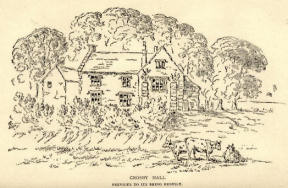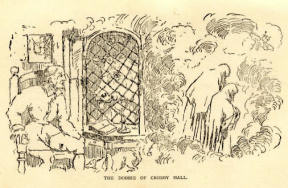CROSBY HALL
 Of
the architecture and character of the Hall little can be said, as it was
almost wholly rebuilt about forty years ago. According to a manuscript
history of Crosby written by Mr. George Gibson in 1801, he says –“in the
time of the Pickerings it is said to have been a building of stately
dimensions in the form of a lofty tower; but this ancient fabric being
suffered to decay was totally taken down and removed almost within
memory,” so that it may now be about 120 or 130 years ago. “The place
was fortified with walls, ditches, and ponds of water, and numbers of
beautiful sycamores were planted all round.” If this was the case, these
trees must now be upwards of 260 years of age, and are, according to the
same author, of the same age as those around Gaythorn Hall. Burn, in
describing the Hall in his day, says: - “In the entrance tower are two
windows, one above the other, of no mean workmanship; above the door are
the letters I.D. for John Dodsworth, who repaired the tower, and cut
those letters in the old work. There is a coat of arms, quarterly of
eight, which seems to have been put up by the Pickerings.” This is now
above the door of the present house, and in the window above are some
portions of stained glass with a coat of
Of
the architecture and character of the Hall little can be said, as it was
almost wholly rebuilt about forty years ago. According to a manuscript
history of Crosby written by Mr. George Gibson in 1801, he says –“in the
time of the Pickerings it is said to have been a building of stately
dimensions in the form of a lofty tower; but this ancient fabric being
suffered to decay was totally taken down and removed almost within
memory,” so that it may now be about 120 or 130 years ago. “The place
was fortified with walls, ditches, and ponds of water, and numbers of
beautiful sycamores were planted all round.” If this was the case, these
trees must now be upwards of 260 years of age, and are, according to the
same author, of the same age as those around Gaythorn Hall. Burn, in
describing the Hall in his day, says: - “In the entrance tower are two
windows, one above the other, of no mean workmanship; above the door are
the letters I.D. for John Dodsworth, who repaired the tower, and cut
those letters in the old work. There is a coat of arms, quarterly of
eight, which seems to have been put up by the Pickerings.” This is now
above the door of the present house, and in the window above are some
portions of stained glass with a coat of
 arms,
Lowther impaling Fleming. A great portion of the moat is still to be
seen; it encloses an area of an irregular oblong; the moat is supplied
with water by a spring at the north corner. The entrance, a mantle tower
and drawbridge were on the north side, next the Church, where the moat
is now completely levelled up. Within this outer moat was another,
immediately around the building, which is also still partly traceable.
Associated with the Hall is a curious legend which has been handed down
in firm belief for two or three generations. The Hall was almost nightly
visited by what was called a dobbie, a supernatural being which was no
small terror to the inhabitants, and which made a great excitement in
the village at the time. Various accounts are given of its form,
sometimes a sheeted skeleton, sometimes a white bull, which was wont to
lick the window-panes at night; it chiefly frequented the old tower, and
when that was pulled down, it ceased its nightly walks; but not till it
disclosed to the old man of the Hall the whereabouts of some hidden
treasure, and also the exact time and manner of his death, which, it is
affirmed, happened accordingly. Another account is that the old farmer
had some hand in making away with the lawful heir, and as a consequence
was haunted by the apparition. This version says nothing about the
treasure; but his death was foretold, and when it happened the dobbie
also departed. The story is well told by Mr. Whitehead, in his
Westmorland Legends, - ending thus :-
arms,
Lowther impaling Fleming. A great portion of the moat is still to be
seen; it encloses an area of an irregular oblong; the moat is supplied
with water by a spring at the north corner. The entrance, a mantle tower
and drawbridge were on the north side, next the Church, where the moat
is now completely levelled up. Within this outer moat was another,
immediately around the building, which is also still partly traceable.
Associated with the Hall is a curious legend which has been handed down
in firm belief for two or three generations. The Hall was almost nightly
visited by what was called a dobbie, a supernatural being which was no
small terror to the inhabitants, and which made a great excitement in
the village at the time. Various accounts are given of its form,
sometimes a sheeted skeleton, sometimes a white bull, which was wont to
lick the window-panes at night; it chiefly frequented the old tower, and
when that was pulled down, it ceased its nightly walks; but not till it
disclosed to the old man of the Hall the whereabouts of some hidden
treasure, and also the exact time and manner of his death, which, it is
affirmed, happened accordingly. Another account is that the old farmer
had some hand in making away with the lawful heir, and as a consequence
was haunted by the apparition. This version says nothing about the
treasure; but his death was foretold, and when it happened the dobbie
also departed. The story is well told by Mr. Whitehead, in his
Westmorland Legends, - ending thus :-
Sometimes it lick’d the window pane,
In shap of a girt white bull;
Sometimes it shak’d the mantle tower,
Sometimes it towl’d the bell:
And this it carried on for years,
To Think on’t maks yan whidder,
Till’t auld man cock’d his teas – an’ than
They beaythe went off togidder.